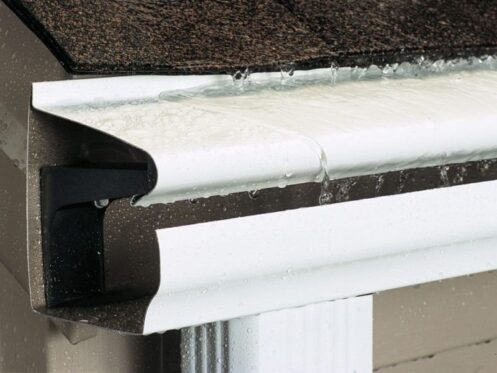You’ve probably seen gutters on the edge of roofs before, right? These shallow troughs collect rainwater and channel it away from the home.
Cleaning gutters clogged up with debris like leaves, twigs, and stocks is a dangerous but necessary job if you’d like your gutters to remain free of obstructions. But what if there was a better way to prevent debris from entering your rain gutters so that you have to clean it up? Well, that’s what gutter guards are for!
Gutter guards allow water to flow through your home’s gutters while preventing debris from clogging them up. There exist hundreds of different types of leafguard gutters on the market. To choose the best type for your house, you need to understand how every type works.
Types of Gutter Guards
Screens
This is one of the most commonly used types of gutter guard. Screens usually cover your home’s gutters using a wire-like membrane that blocks debris but allows water to be collected. Screens need to be removed for routine cleaning every once in a while. They vary in cost and installation expense but can easily be installed by a homeowner.
Inserts
This type of gutter guard is the easiest to install as no tools or skills are required and the most cost-effective option. Inserts are usually made of wire mesh and foam and have a porous-like quality. They typically accumulate debris after being placed in a home’s gutters for a while and need to be cleaned routinely.
Toppers
This is a more expensive option. Unlike the other two types, toppers need to be installed by a professional to ensure they work well. They have a curved shape and require maintenance, just like the other gutter guards. However, it may be hard for toppers to collect and divert excess water into the gutters with heavy rains.
LeafGuard Gutters
LeafGuard provide various benefits, the most important being that they protect your house from severe home damage. Let’s look closer at some of these benefits.
Benefits of Gutter Guards
Protect your house
Clogged gutters prevent water from flowing through your gutter system, which increases the risk of water pooling against the board between the side of your house and the gutter. Water pooling against this board can cause it to disintegrate, which may damage the structure.
Water spilling onto the roof of your home can also cause leaks inside your house. Additionally, clogged gutters may cause water to pool at the base of your home, which may damage your home’s foundation.
Fixing these problems is costlier than having a gutter guard installed, which is why you should choose to have your leafguard gutters installed as soon as possible.
Eliminate the need to clean your gutters
Without gutter guards, you’ll have to clean your gutters frequently after they’ve been blocked by debris that’s entered your gutter system. If you’d rather not do the job yourself, it may cost you about $150 on average to get your gutters cleaned once a year.
This means you’ll have to part with about $300 annually to get your gutters cleaned, as two cleanings are recommended for uncovered gutter systems. However, if you install a gutter guard, you’ll only have to clean your gutters once a year or every other year, which is less expensive.
Help keep pests away
Apart from keeping your gutters free of debris, leafguard gutters also help deter or block pests from making new homes in your gutter system. They do this by creating a barrier between birds, rodents, snakes, and your gutter, making them the first defense line against a major pest issue.
Not having a gutter guard allows pests to live in your gutter, making it easier for them to cause damage to your house. Clogged gutters are also a breeding ground for insects like mosquitoes, which you’d probably like to avoid.
Offer protection from fires
Gutter guards help block debris from blocking the gutter and drying out, which makes good kindling for any fire. Given that the roof is one of the vulnerable parts of a house during a wildfire, leafguard gutters can be a very wise investment.
Minimize mildew and mold
Leaves, twigs, and branches are the most common materials that clog gutters. Sometimes, these materials harbor mold spores which flourish well inside clogged gutters. When a clog causes water to spill over onto the side or roof of your home, your fascia board and other housing materials may rot, making it easy for mildew and mold to find their way into your home.
Mildew and mold are not good for your health. It’s especially dangerous for individuals with allergies or respiratory conditions like asthma. Given that the average cost of removing mold from 200 ft2 of your home is $2500, wouldn’t it be better to have gutter guards installed?

